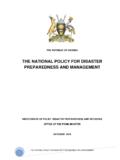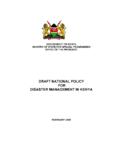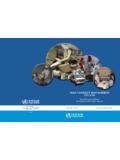Transcription of Project Proposal for Improving the Health Environmental ...
1 1 world Health organization Country Office-the Islamic Republic of Iran Project Proposal for Improving the Health & Environmental conditions in Earthquake affected Areas of Lorestan Province, the Islamic Republic of Iran 2006 I. BACKGROUND On 31 March 2006 a series of earthquakes nearing 6 on the Richter scale shook many parts of Lorestan Province in the Islamic Republic of Iran, particularly the rural areas of Dorud and Boroujerd districts. Fortunately the tremors served as an early warning system and the people left their homes in time to prevent a large scale human disaster. According to government statistics, 72 people died and 1418 were injured, while 320 villages were damaged (10-100%).
2 Sixty villages were completely destroyed. Nearly 15 000 buildings suffered damage of more than 50% in 8 affected cities of Lorestan. Some 33 000 units were destroyed or severely damaged in the affected villages. It is estimated that around 12 000 domestic animals, the key source of people s livelihood, were killed. The majority of the population in the affected villages were farmers or nomad animal breeders of low socioeconomic status with poor conditions for sanitation and hygiene. The Health system was seriously affected by the earthquake. Fifty-three different Health facilities serving a total population of over 60 000 in 138 villages were affected in Dorud and 100 villages hosting over 50 000 in Boroujerd.
3 The damage to the two main hospitals in Boroujerd, with a total bed capacity of over 200 (100 beds each), required evacuation of most of the injured victims to the nearby cities and provinces. Being a disaster prone country, particularly for earthquakes, forces the Islamic Republic of Iran to face one of the main challenges in achieving sustainable Health development. The most deprived areas of the country are taking the heaviest burden. Among the most significant problems associated with the earthquake affected areas are deforestation, soil erosion, depletion and pollution of water resources, unhygienic conditions and precarious sanitation due to scarcity of safe drinking water, lack of latrines and showers.
4 Other considerations include changes in the psychosocial and economic welfare of local communities during prolonged residency of the affected population in temporary settlements. These have impact on the physical and mental Health which can alter the social context and habits of people on short and long term bases. Although Environmental concerns have taken a back seat to humanitarian needs at such times of crises, the close links between the well being of human populations along with quality of life and Environmental Health are being increasingly recognized. In addition to the collapsed homes and dead animals, the water supply systems had been destroyed in some of the villages, posing serious threats to the Health of the communities.
5 Increased incidents of certain communicable diseases especially water-borne (eg. diarrhoeal diseases), and other enteric and zoonotic infections remain a major cause of ill- Health particularly for women and children. The rate of collection and removal of solid waste in the affected areas remains slow because of lack of appropriate and adequate mechanized procedures. Moreover, communities in the affected villages keep their domestic animals within or adjacent to the households resulting in serious Health problems and poor Environmental conditions . Environmental sanitation remains poor in spite of the efforts exerted by the local government. 2 II.
6 OVERALL RESPONSE Despite the devastation caused by the disaster, the response of and cooperation between the Iranian authorities, Iranian Red Crescent Society (IRCS) and organized Forces was swift and exemplary. Various government agencies including the Ministry of Interior, Ministry of Health , the Army, Organized Forces (Army and Basidj) and the IRCS contributed to the rescue and relief operation. The International Federation of Red Cross and Red Crescent (IFRC), the Iranian Red Crescent Society (IRCS) and some of the INGOs (ACF Spain, MSF France and Caritas Italy) active in the country mobilized quantities of relief items including: tents, blankets, hygiene kits, chlorine tablets and powder as well as technical support.
7 The government and Caritas Italy provided a limited number of emergency latrines and showers to some of the most affected villages. At present, all earthquake affected villages in both districts of Dorud and Boroujerd are witnessing a quick reconstruction movement, thanks to the loans given by the government for reconstruction of individual houses, expected to be concluded before fall of the next winter. However, the loan is barely sufficient for building of the residential area and no provision was made for construction of animal dwellings, contributing to the prevalent behaviour of animal breeders of keeping their domestic animals in their residence, hence maintaining the risk of transmission of zoonotic diseases.
8 The provincial and district governments exerted considerable effort to restore the safe water supply to affected areas by repairing the broken pipes, maintaining adequate chlorination and supply to needy areas by mobile tankers. However, Environmental sanitation is still precarious. The main problem remains animal waste (dung) and garbage and the need for construction of latrines and showers which did not benefit from adequate attention from the local authorities nor the communities. WHO IMMEDIATE RESPONSE TO THE EARTHQUAKE Within 24 hours of the earthquake, WHO deployed an emergency field officer, as part of the UN response team, to the affected area for rapid assessment of the situation.
9 Later, WHO augmented its presence in the field with two more technical staff (program assistant and logistic officer) to assist the MOH and partners and to ensure effective coordination of Health cluster response. 3 Soon after the rapid assessment, WHO dispatched two New Emergency Health Kits (NEHK), to the two main districts affected by the earthquake, Dorud and Boroujerd, sufficient to cover the Health and medical needs of 20 000 for a period of 3 months. To enhance access to quality primary Health care services for the affected population, WHO managed to secure necessary funds to establish four fully equipped emergency Health centers (HCs) by providing prefabricated containers and basic medical and general equipment and furniture.
10 Two HCs were established in two of the most destroyed villages in each of Dorud and Boroujerd. Three villages in Dorud were also enforced with prefabricated containers to make two HHs functional. III. WHO IN THE ISLAMIC REPUBLIC OF IRAN IN BRIEF WHO has six core functions built on its mandate: Providing leadership on matters critical to Health and engaging in partnerships where joint action is needed. Shaping the research agenda and stimulating the generation, translation and dissemination of valuable knowledge. Setting norms and standards, and promoting and monitoring their implementation. Articulating ethical and evidence-based policy options.










![Disaster Management Act [No. 57 of 2002]](/cache/preview/e/5/d/2/b/3/6/7/thumb-e5d2b36743b64ebe9204d7e874f734ad.jpg)





